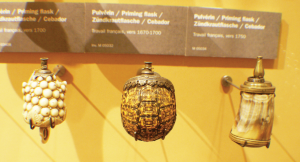by James C. Fulmer | NMLRA Past President
“To the Republic,” that is what my son Mark said in greeting one of the French officers in class with him at the Joint Services Command and Staff College at the Defense Academy of the United Kingdom. I could have never known what great adventure my wife Linda and I were about to have on this trip. My oldest son, who is in the US Army, had a chance to go to school and receive a masters degree in Great Britain. We decided to attend his graduation and to see my new grandson, Oliver Hart Fulmer, for the first time. Oliver was born in England soon after his parent’s arrival at the school.
Mark had told many stories to his fellow classmates about growing up and my family’s love for history and muzzleloading firearms. Once some of his classmates learned I was also going to Paris, France, they told me that Napoleon’s Tomb, located in the central crypt of the Eglise du Dome (Church of the Dome) at the Hotel des Invalides, (Residence of the Invalids), is a “must see” place to visit. Also the Army Museum is located at the center of the Hotel des Invalides and had more muzzleloading cannons and firearms than I could imagine.
We were only going to be in Paris overnight and there is a lot to see. Our time was pretty well scheduled without too much room for more. We took the earliest train from London to Paris, so we would arrive at our hotel by 9:30 a.m. We left the bags at the hotel and jumped on a bus and headed for the Louvre. The Louvre is huge. I recommend at least taking one tour of some of the highlights or you will be lost forever. I didn’t see any muzzleloaders there, but I did see the Mona Lisa and a bunch of artwork and sculptures. They were made by people who I believe would have done well building and engraving muzzleloaders.
After the tour of the Louvre we headed back to check into the hotel and eat dinner. That was when we figured out how to work the Hotel des Invalides into our short visit. We had a return train to London for 4:45 p.m.
the next day, and if we did the Eiffel Tower that night after dinner, and didn’t see Notre Dame the next day we could do Napoleon’s grave and the Army Museum from 10:00 a.m. to 2:00 p.m. before we left Paris.
Being at the top of the Eiffel Tower at 11:00 p.m. with all the city lights of Paris lighted up was a pretty sight. We made it back to our hotel probably on the last bus running that night on route from the Eiffel Tower.
We got up early the next day and found ourselves at Napoleon’s Tomb at the Eglise du Dome at the Hotel des Invalides. The history of the Hotel des Invalides is very interesting. Louis XIV gave an order on Nov. 24, 1670 to build a home and hospital for aged and unwell soldiers. The project was completed by 1676 and it was felt the veterans required a chapel. The chapel was finished in 1679 and was known as Eglise Saint-Louis des Invalides and daily attendance was required for all the veterans. Shortly after the veteran’s chapel was finished, Louis XIV commissioned the construction of a separate private royal chapel attached to the veteran’s chapel and it is referred to as Eglise du Dome. It was finished in 1708.
Because of its location, about the center of Paris, it was in several key events in French history. On July14, 1789, it was stormed by the people of Paris who seized the cannons and muskets stored in its cellars to use against the Bastille later that day.
Napoleon, who died May 5, 1821, on the island of St. Helena, was buried in the Geranium Valley. He rested there until October 15, 1840, when, with a great ceremony, he would be entombed in Paris and eventually come to rest at the present day Eglise du Dome.
In 1872 an Artillery Museum was located within the building to be joined by the Historical Museum of Armies in 1896. The two institutions were merged to form the present day museum in 1905. This museum contains some of the world’s most




